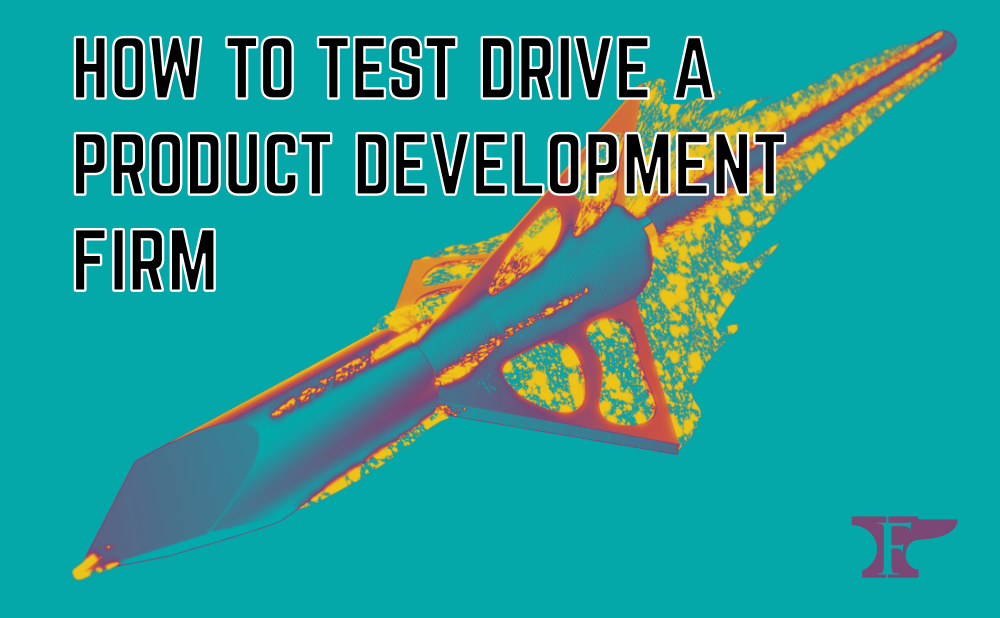WHY AND HOW TO TEST DRIVE A PRODUCT DEVELOPMENT FIRM

Finding a great product engineering resource can be a huge boost to your business, allowing you to quickly fuel growth by bringing new, better products to market. At the same time, a design firm that is slow, communicates poorly, or is overly expensive can be a major detriment.
How do you separate the good from the bad? We recommend a two part approach. The first step is evaluating a bunch of firms using our "9 Questions to Evaluate a Product Development Firm" post as a guide. The ones that answer the questions well, based on your companies unique needs, move on to the second step, the test drive.
WHY TEST DRIVE A FIRM
Unlike getting samples from a manufacturer, testing a design firm can be done with very little time or financial investment, but provide huge benefits. One of the difficult parts about evaluating any service is that there are so many aspects to compare. Of the nine areas outlined in our questions post, many of them are particularly difficult to gauge without working with the firm. The test project allows you to get great information on these areas for very little cost and risk. The test-drive is a strategically structured project that helps to create concrete experiences and data, to help you reveal and evaluate all of the hidden aspects of a firms service.
HOW TO GET THE MOST OUT OF YOUR TEST
Pick the Right Project
We recommend picking a relatively small to medium sized project for your company. This helps to minimize your loses and delay if the firm is not able to deliver. It may also help to choose something that is a little further back in your queue. This will reduce the chance that the project will adversely affect other aspects of your company, if there are delays.
If possible, pick a project that is similar to others you have done in the past. This will allow you to directly compare the firms price and performance to your previous experience.
Be sure that the scope of the project covers all of the areas of service that you want to test. For example, if the project does not require engineering drawings, but you normally get them on your other projects, ask for them anyways. It is better to pay a little more on a small project now, to sample all the aspects of the company, then to wait for another project where the stakes might be higher.
Take a Wide View
Remember, there is more to this project then just getting the work done. The real purpose of the test-drive is to evaluate the process and how well you work together, as much as the final product. Each time you check in with the development team, evaluate how you feel about the project. Ask yourself:
- Are they easy to communicate with?
- Do I feel connected to and in tune with the progress of the project?
- Does the firm feel reliable and responsive?
- Is the project running smoothly and on schedule?
These types of questions will help you pull back and look how the service is being delivered, not just what it is delivering.
Review the Deliverables
When the project is complete, thoroughly review the delivered media. Gather the applicable people on your staff and ask them to look at the documents. They will likely find changes they would like to see. Take those changes back to the firm and see how willing they are to make updates. Repeat this process with your downstream vendors. For example, If you manufacturer out of house, ask your manufacturers to take a look. Will the delivered documents allow them to do their job well? Again, they will likely ask for more changes.
This process has two benefits. First you get to thoroughly evaluate the final quality of the product by asking others to review it. Second, if you choose to use the firm in the future, their team will now have a clearer understanding of what your expectations and preferences are.
The reviews should happen very soon after the firm delivers. Partially because it is good practice to quickly provide feedback, but mostly so that your team can keep the experience of working together fresh in their minds before the final review.
Have a Wrap-Up Meeting
After the project is complete, have a meeting with the firm to discuss the product and how it was delivered. Talk about the project and see what the firm thought of their work and service. Do they feel like they performed well, or were there areas that they feel they could improve? If the work was quoted upfront, using pay by project vs pay by hour, how close was the actual price to what they quoted? How might they adjust their quotes in the future, now that they have experience with your firm and products?
Pay attention to their tone, do they seem receptive to your needs and willing to adapt? A mediocre firm that is willing to change and improve their service may be better in the long term, than a company that did well on this project, but seems closed off.
Finally, if the project went well, this meeting is a great time to brainstorm ways to work better in the future, and can serve as the kickoff meeting for the next project.
Testing development firms can be invaluable when trying to grow your business. Not only do you get to advance some of your back-burner projects, but you can inexpensively sample the design services market. Putting in the effort to vet and then trial a few firms can help you select a quality company that perfectly matches your needs and budget. Once selected, you can confidently move forward in building a partnership that will improve your business for decades to come.
